Loddon and Clavering, Norfolk
Up to 1834
Established in 1764, Loddon and Clavering was one of the Norfolk Incorporations formed by special Acts of Parliament in the third quarter of the eighteenth century. In 1765, the Incorporation, which comprised 41 parishes, erected a workhouse for up to 400 inmates at Hales. The large H-shaped building contained 83 "apartments" and was built by John Harris of Ipswich at a total cost of £8,300. It was constructed from bricks which cost 15s per 1000.
The building included an infirmary "to serve as a hospital for the reception of such aged, sick or infirm persons and young children, as are not able to work", and a prison or "House of Correction for the punishing and keeping to hard labour such idle and disorderly persons who being able shall refuse to work or otherwise misbehave themselves". In 1766, a pest house for up to 20 "persons afflicted with the small pox or other infectious disorders" was erected at the east of the workhouse. At the end of 1773 and in 1774, a "putrid fever" raged in the workhouse and surrounding neighbourhood resulting in a high number of deaths.
The able-bodied men were employed in cultivating 9 acres of land, 3 of which were used as a garden for raising greens and vegetables for the house. The able women, most of then in the workhouse "for bastardy" were employed in washing, getting up linen, nursing &c." The net income from pauper labour in 1774 was £166.0s.11d. Twice a year, a sixth of this income was distributed "to the industrious poor, in proportion to their merit, for their private use."
The officers of the workhouse were the chaplain (£25 per annum), surgeons and medicines (£80), governor (£40), treasurer (no salary), clerk (£25), schoolmaster (£6), clerk of the peace for auditing accounts (£2.2s).
After 1834
By 1835, the Heckingham workhouse had gained a reputation as being the most disorderly, inefficient and corrupt of the Norfolk Hundred workhouses. Assistant Poor Law Commissioner, Dr James Kay, compiled a highly critical report on the establishment which appeared in the Poor Law Commissioners' Second Annual Report in 1836:
The disorder and turbulence of the inmates were such as to triumph over the authority of the governor, and to render it so evident that the property of the Incorporation was endangered by the presence of this lawless crowd within the walls, that the magistrates applied for the interference of the Commissioners.
...
In most of these houses the paupers were allowed holidays, when all the inmates departed whither they pleased. This indulgence was doubtless permitted to enable the paupers to visit their friends and relatives; but the consequences were generally fatal to the discipline of the establishment, and the morals of both sexes.
91. In the Heckingham House of Industry, this day of sports recurred every week, the inmates being freed from all restraints on Sunday. The paupers had made abundant provision for the enjoyment of this licence; it was found profitable to erect two beer-shops in the immediate neighbourhood, which were usually crowded with paupers on this day. The women had boxes in the neighbouring cottages containing dresses, which, as soon as they were released, they exchanged for the workhouse garb, and thus attired in a more attractive style, flaunted about the neighbourhood in the company with the young men; and Sir Edmund Bacon, whose estate at Raveningham is close to the workhouse, complained to me that his woods were infested, as though they were the groves, and the workhouse the temple, of Isis.
In the autumn of 1835, extensions and alterations were carried out at the workhouse in order to allow the classification and segregation required under the 1834 Poor Law Amendment Act. The work was carried out by local builder Robert Ward at a cost of £3,145. In January, 1836, a group of male inmates rioted an pulled down one of the new walls. Three of those involved were sentenced to hard labour at the Norwich Castle House of Correction. In April, the workhouse was set on fire causing damage estimated to cost £3,000. A £200 reward was offered by the Norwich Union insurance company for the conviction of those responsible. A former inmate, James Barrett, was arrested but never tried, presumably because of insufficient evidence.
In May 1836, the Loddon and Clavering Incorporation was dissolved and a new Loddon and Clavering Poor Law Union was instituted in its place on 7th May 1836. Its operation was overseen by an elected Board of Guardians, 44 in number, representing its 42 constituent parishes as listed below (figures in brackets indicate numbers of Guardians if more than one):
County of Norfolk: Aldeby, Alpington, Ashby St Mary, Bedingham, Bergh Apton, Brooke, Broome, Burgh St Peter, Carleton St Peter, Chedgrave, Claxton, Ditchingham (2), Ellingham, Geldeston, Gillingham All Saints, Gillingham St Mary, Haddiscoe, Hales, Hardley, Heckingham, Hedenham, Hellington, Howe, Kirby Cane, Kirstead, Langley, Loddon (2), Mundham, Norton Subcourse, Raveningham, Seething, Sisland, Stockland, Thorpe next Haddiscoe, Thurlton, Thurton, Thwaite, Toft Monks, Topcroft, Wheatacre All Saints, Woodton, Yelverton.
The population falling within the union at the 1831 census had been 13,680 with parishes ranging in size from Hillington (population 52) to Loddon (1,175). The average annual poor-rate expenditure for the period 1834-36 had been £6,494 or 9s.6d. per head of the population.
The new union took over the former Incorporation workhouse and the Poor Law Commissioners authorised and expenditure of £3,145.10s. on repairs to of the building for use by the union. In 1837, James Kay reported that "The workhouse, the state of accounts, and the administration of relief in this Union are in every respect satisfactory." This state of affairs was not to last long — in 1842, the workhouse master was dismissed after being discovered replacing cheese in the inmates' diet by cheap broth, and selling off for his own gain honey and plants produced at the workhouse.
The workhouse site layout is shown on the 1905 map below.
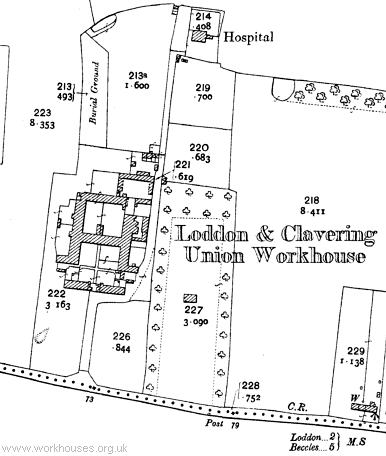
Loddon workhouse site, 1905
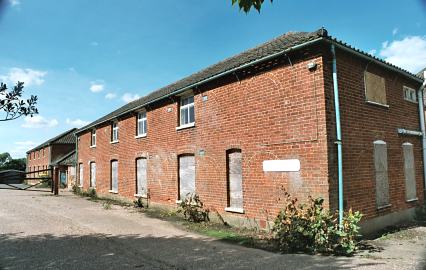
Loddon entrance blocks from the south-east, 2001.
© Peter Higginbotham.
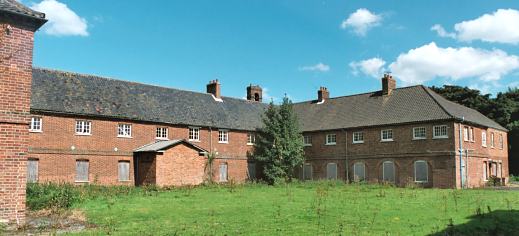
Loddon main building from the south-west, 2001.
© Peter Higginbotham.
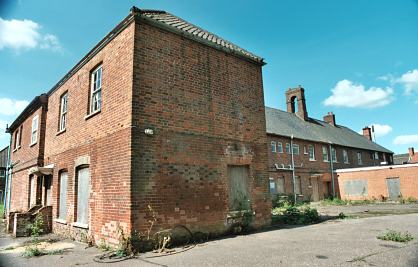
Loddon main building from the south-east, 2001.
© Peter Higginbotham.
The workhouse bell which used to hang above the east wing now adorns an adjacent old people's home.
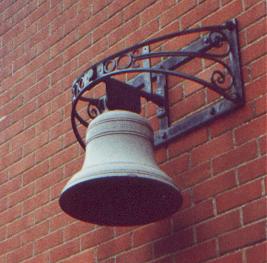
Loddon workhouse bell, 2000.
© Peter Higginbotham.
A memorial to the former inmates of the workhouse and hospital has been erected in the nearby Heckingham churchyard.
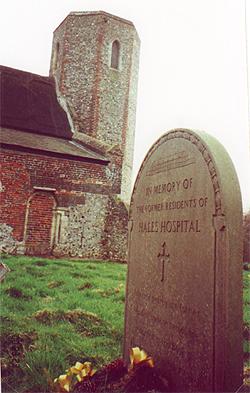
Heckingham churchyard, 2000.
© Peter Higginbotham.
In 1927, the workhouse was closed and the building converted into an institution for "mental defectives". After 1930, control passed to Norfolk County Council and the establishment was renamed Heckingham Institution. In 1948, it became part of the National Health Service as Hales Hospital which closed in around 1990. The buildings are currently empty and awaiting redevelopment.
Staff
Inmates
Records
Note: many repositories impose a closure period of up to 100 years for records identifying individuals. Before travelling a long distance, always check that the records you want to consult will be available.
- Norfolk Record Office, The Archive Centre, Martineau Lane, Norwich NR1 2DQ. Holdings include: Guardians' minute books (1769-1930, with gaps); Admissions and discharges (1772-85, 1845-1923); Baptisms (1825-1923); Burials (1825-1929); etc.
Bibliography
- Abstract of the Returns from the Governors, Directors etc. of the Several Houses of Industry, and Workhouses, Specially Established for the Relief and Employment of the Poor (1776).
- Hales Hospital - A History by John Bilyard (Norwich Health Authority, 1987)
- Pauper Palaces by Ann Digby (Routledge & Kegan Paul, 1978)
Links
- None.
Unless otherwise indicated, this page () is copyright Peter Higginbotham. Contents may not be reproduced without permission.


